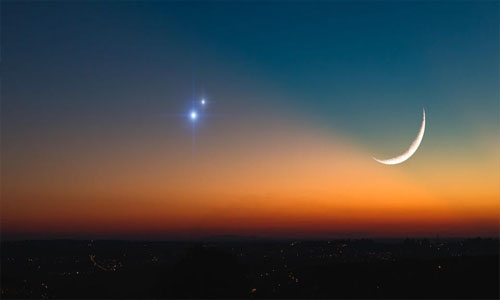Venus and Mars to decorate Bahrain skies, says astronomer Ali Al-Hajri
TDT | Manama
The Daily Tribune – www.newsofbahrain.com
July is a good month for planet gazers. Experts point out that not only pluto is reaching opposition, but Venus and Mars are coming close to one another. And they will be separated by less than the diameter of a full moon at its peak.
This amazing sight will be only visible in the western sky or horizon under clear sky conditions after sunset. The event is up for skywatchers until next Tuesday. Experts point out that Venus and Mars at their closest can are viewable using ordinary binoculars.
Astronomer Ali Al-Hajri says this event called conjunction occurs after sunset at 06:33 pm next Tuesday. This planetary meet up at its closest approach will be a mere 28.1’ apart. The peak of the celestial magic occurs at 04:38 pm, says Al Hajri, citing the surface calculation of the Bahrain horizon. “This conjunction that occurs before sunrise could be seen only using a telescope.” “It might be possible to see Venus through a telescope, given that the atmosphere is clear.” So, one should wait a few more minutes after sunset to see the pairing with naked eyes.”
Al Hajri further said that the day before the conjunction on Monday, the crescent of DulHijjah would also be a distinctive sight on the western horizon after sunset. Dul Hijjah, which begins this year on 11 July, is the month of the Hajj pilgrimage and the last month of the Islamic calendar. Hajj will start on Dul Hijjah 7 (17 July) and end on Dul Hijjah 11 (21 July). The day of Arafat will fall on Dul Hijjah 9, 19 July.
Spot Venus
Al Hajri further explained that it is easy to spot Venus for its brightness in the western sky. “This also allows us to monitor the spacing between the planets, starting next Wednesday.” Al Hajri said that the closest interplanetary coupling occurred was on 24 August 2019. “This event, however, was not visible to naked eyes due to its proximity to the Sun by about 3 degrees.” The last visible phenomenon to our eyes occurred on 5 October 2017 and will repeat, he added.
“The event will come back on 8 January 2026 but will not be visible to naked out for its proximity to the Sun,” Al Hajri said. It was also just nine months ago that Mars came within 38.8 million miles (62.43 million kilometres) of Earth, the closest it had been to us since August 2003, and it will not be that close again until September 2035.
Astronomer Ali Al-Hajri
Related Posts


